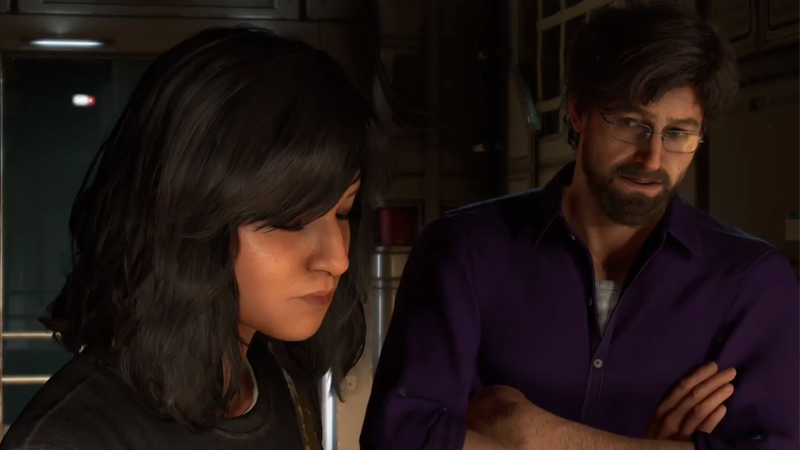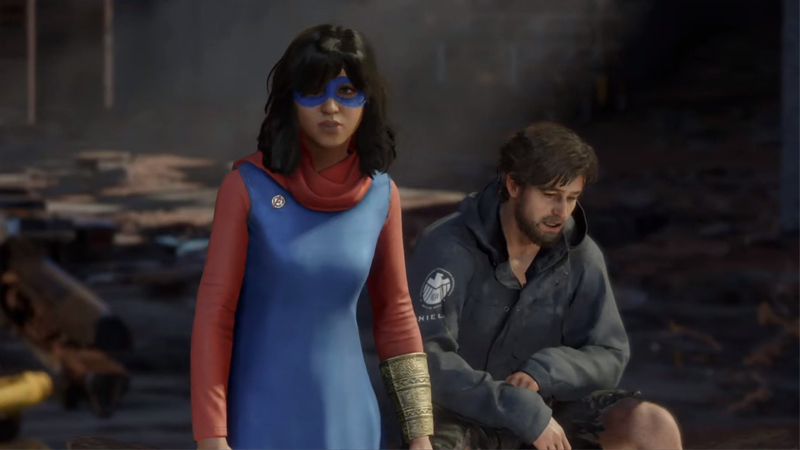The story of Crystal Dynamics and Square-Enix’s Marvel’s Avengers caught many off-guard heading into the grindy, loot-driven brawler, expecting a perfunctory tutorial to the game’s all-encompassing live-service mechanics. Instead, we got maybe one of the most sincerely intimate Avengers stories in years, and it works because of the game’s true stars.

It’s no longer really a secret that Captain America isn’t the star of Marvel’s Avengers, or even Iron Man, or Black Widow, or really, any of the main Avengers we spent months seeing plastered over trailers and box arts. Instead, it is now rightfully known that Kamala Khan, the magnificent Ms. Marvel — played with pitch-perfect joy by Sandra Saad — is the true heart of what makes Marvel’s Avengers story campaign click.
Kamala is the lens through which we see almost entirely everything in the game. From the opening events of the “A-Day” celebration of all things Earth’s Mightiest — which Kamala has VIP tickets to with her dad for entering a fanfiction contest — to the disaster that ensues and “kills” Captain America, we get her take on not just the tragedy that unfolds but are presented with her worldview of the Avengers. And it’s one of sincere love.
[referenced id=”1390057″ url=”https://gizmodo.com.au/2020/09/marvels-avengers-is-making-me-feel-like-superheroes-kill-a-lot-of-people/” thumb=”https://gizmodo.com.au/wp-content/uploads/2020/09/05/yoy694rjyksy29orsgnr-300×169.jpg” title=”Marvel’s Avengers Is Making Me Feel Like Superheroes Kill a Lot Of People” excerpt=”Square-Enix’s Marvel’s Avengers establishes early on that as you and the Avengers journey across the world on a quest to defeat MODOK, you’ll have to fight countless AIM-branded robots based on Stark technology that are all programmed to target Inhumans and eliminate heroes on sight.”]
There’s unfiltered adoration, yes: Kamala is a fangirl through and through, rendered breathless explaining Iron Man’s first repulsor gauntlet, or quoting an actual Captain America comic book quote at some bullies (the “You Move” speech from J. Michael Straczynski, Ron Garney and Scott Hanna’s Amazing Spider-Man #537, fact fans). But we’re also immediately shown how her heroes have inspired her to be the good person she is — her loving relationship with her father Yusuf and that she channels her admiration for the Avengers not into recollecting factoids and buying merch (although she does that too), but her own morals and her creativity through art.

It’s important to bludgeon that into our heads from the get-go in the game because it means what comes immediately afterward — a cataclysmic event that levels San Francisco, kills thousands including Captain America, and transforms even more, Kamala included, into Earth’s first wave of Terrigen Mist-imbued Inhumans — and her worldview through it hit home all the harder. The game picks up five years after its initial prologue to reveal that the Avengers have shattered, declared outcasts by law and shamed for their part in the A-Day calamity. While Advanced Idea Mechanics Technologies (headed by the one-two punch of not-at-all-evil scientists Monica Rappacini and George Tarleton) has swooped in to become a ruling police-state monitor for Inhuman activity and cracking down on American cities, Kamala — still literally a teenager — has adapted to her strange new powers and become a vigilante, training, hiding, resisting, because it’s what her heroes would do in her eyes. Even if, in the real world, they did not.
That desire to match her dreams to reality (and join the growing resistance against AIM brewing in Utah) puts Kamala on a stretchy collision course with the most important character she meets in all of Marvel’s Avengers: Bruce Banner (Troy Baker, the voice of basically every other male character in AAA video games). After coaxing the doctor out of his hulking form — which Bruce confides he’d been stuck in for over a year before she encountered him — Kamala immediately finds herself with a foil that challenges her over the course of the entire game. She is this beacon of optimism, still a little fearful of what her powers can do, but earnest in her belief that she can step up to be an Avenger worthy of what that title means to her. Her first encounter with one of her idols is not with the smiles she got as a fangirl on A-Day but a man who, rage-monster or not, does not want her anywhere near him or thinking that he’s a hero.

The Bruce we meet through Kamala is a man utterly broken. Not by the push and pull of the creature within him, but by the actions he took as Bruce Banner that lead to the unsafe tests that caused the A-Day cataclysm. Bruce believes, despite the insistence of anyone around him, that Cap’s death and Kamala’s very existence is entirely on him. It’s a grief that completely and utterly causes him to lose himself. It’s his verdict that broke the Avengers apart in court, his shame that leads to him hiding out in the junked graveyard of their former mighty base, the Chimera Helicarrier. This is a Bruce who didn’t give in to the Hulk but retreated into his ginormous, green arms, to numb the process of thinking about the blame he feels.
[referenced id=”1232584″ url=”https://gizmodo.com.au/2020/07/iron-man-vr-is-a-perfunctory-superhero-story-but-with-some-clever-virtual-twists/” thumb=”https://gizmodo.com.au/wp-content/uploads/2020/07/21/vfmg4p97ez78cfiqzh4n-300×169.png” title=”Iron Man VR Is a Perfunctory Superhero Story, But With Some Clever Virtual Twists” excerpt=”If you were coming into Sony’s recent Iron Man VR game expecting something on the level of what it and Insomniac did with Marvel’s Spider-Man, you’re probably going to be disappointed with its by-the-numbers tale. But while its story itself doesn’t particularly soar as high as the Iron Avenger, the…”]
This dynamic is not a particularly original storytelling device — the plucky young idealist and the traumatized vet — but it’s a suitably engrossing one that Marvel’s Avengers spends most of its campaign mode mining for all its worth. It becomes emblematic of the teamwork that the Avengers embody as a unit: Kamala, through Bruce, learns to accept who she is and what she’s become in the wake of A-Day and to embrace that her powers are not some othered part of herself but part of what makes her the person she is. Bruce likewise, through Kamala, is given a reminder of why he used the Hulk as a tool for heroism in the first place, why he worked so tirelessly as a scientist outside of the stretchy purple pants to try and make the world a better place.

It’s not an easy path for the duo — for a lot of the game, the anxiety and guilt-ridden Bruce cannot help but see Kamala as a walking, talking embodiment of his failure, leading to dark moments where, right in front of her, he is desperate to foist his new charge off onto other people as soon as possible. He needs a reprieve, a chance to return to his self-flagellation. But over the course of Marvel’s Avengers, her sincerity, her optimism, her almost stubborn inability to do anything but see the good in things transforms Bruce as much as the fateful gamma radiation accident did all those years ago. Instead of seeing her as a black mark on his life, she becomes a beacon, a reminder to him of why the Avengers existed in the first place.
Even when the game’s campaign mode builds to its climax with the revelation that Captain America didn’t perish on A-Day, but was secretly being kept alive to be drained of supersoldier serum, aiding Tarleton’s transformation into MODOK (comic book superhero stories? Cheating death? Well, I never!) and his return to the team comes to the fore of the story, Kamala and Bruce remain the story’s heart. It’s the relationship that, in the lowest moments narratively, brings our heroes back from the brink. It’s the catalyst for the final setpiece: fighting a MODOK-enhanced Kree Sentry that was secretly submerged beneath San Francisco’s ruins, Kamala embiggens into a gargantuan form of herself to smash it to pieces, after watching the Hulk nearly battered to death by it.
It is why the most poignant part of the conclusion isn’t Kamala being reunited with her father after months on the run, but a small, intimate moment, when a nervous Bruce pulls her aside and, reflecting Kamala’s sincerity on herself, thanks her for saving not the Avengers, but him.

Marvel’s Avengers would’ve been a lesser story if, like its back half, it leaned a little too much into the grand scale and epic team-uppery that comes as part and parcel of an experience with this group of characters. But the powerful choice of not just framing the road to that grand action through Kamala’s eyes, but also really anchoring her lens into the team through Bruce, makes that scale feel earned, for once.
The Simpsons really did put it best: a noble spirit embiggens the smallest man.
